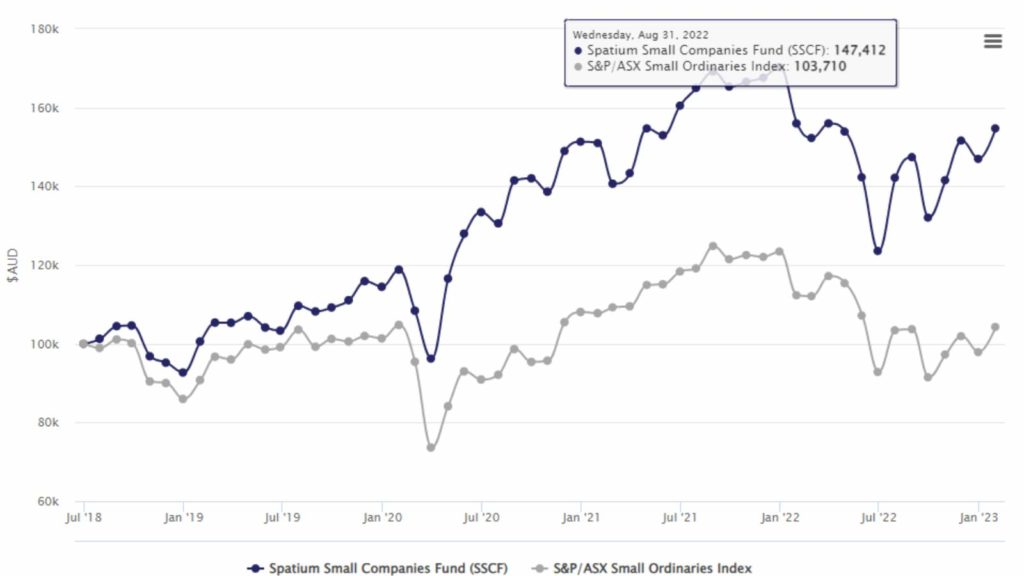The grassroots Spatium journey from startup SMA to thriving managed fund
Historically, the birth of a managed fund is preceded by significant capital backing from an existing money manager, one with a track record of performance, both institutional and wholesale distribution channels, operational precedents and an established modicum of trust in the market.
But not always. For Spatium Capital founders Nicholas Quinn and Jesse Moors, the genesis of the flagship Spatium Small Companies Fund involved a tightly held conviction in their short-holding, long-only strategy, a handful of faithful seed investors, and a formative period proving their mettle generating alpha in a separately managed account (SMA).
Their journey is uncommon, but one marked with perseverance. Among the many challenges the two faced was their relatively young age; Moors is now 31, Quinn 28.
No playbook
In truth, the SMA-to-managed fund transition isn’t even one they’d recommend. While their managed fund is now rated by SQM Research and (after lobbying by advisers) available on the HUB24 investment platform, Moors says shifting from SMA to managed fund meant essentially starting from scratch. Despite the managed fund being shaped as a virtual mirror image of the SMA, re-birthing as a unit trust meant years of track record got left behind.
“Looking back on it now, we probably just would have started with a managed fund because research houses can’t recognise something prior to the fund due to their own obligations,” Moors tells The Inside Adviser. “It’s a little bit of a kick in the guts, we effectively lost over 20 months of track record.”
The shift also meant commencing the fund before the SMA was liquidated to avoid time out of the market. “It’s a nerve-wracking exercise,” he continues, “but we were able to make that transition quite seamlessly.”
Despite the downsides, Moors says he doesn’t regret the path he and Quinn took with the fund.
“I don’t know if we necessarily would look at it as a missed opportunity, because if we didn’t have the SMA we wouldn’t have the fund and the performance and the clientele that we have now,” he explains. “So it was a necessary evil at the time. But I think this is a pretty common thread in the funds management space in Australia that there’s no, there is no playbook.
The budding money managers originally kick off their SMA with a $100,000 investment from an SMSF trustee, followed by another, similar tranche from a separate investor. From those relatively humble beginnings, the fund grew through simple outperformance and word of mouth.
A composite calculation of the SMA’s inception in 2018 through to the managed fund’s inception (net of fees, before tax and assuming reinvestment of distribution) shows a better-than 50 per cent return.

Hunting for dislocation
The investment managers look for mispricing or “dislocation” in the ASX300 and generate alpha via short-term holds. By their own admission, it’s not a strategy everyone is comfortable with. The inherent risk is mitigated by a proprietary filtering mechanism and the combined expertise of the two.
“With end-of-day adjusted data, we strip out the macro news, small company, sector-based influences, and then we try to work out why the pricing is wrong,” explains Quinn. “The final two filters are then ‘well, how long has this decayed?’ If it’s seven to 21 days, we know that there’s probably something that the market has momentarily missed. And then the final pass for us, before we look into actually going into these companies, is to determine the entry and exit prices: is there enough of a spread between what we want to buy it for and what we want to get out for?”
With the proliferation of ETFs in the market and the influx of passive money in the market, Quinn says the fund seeks to take advantage of “the erosion of price discovery for equities”.
Mis-pricing in a number of scenarios, he says, such as a significant investment plunge by a pension fund, or something sentiment driven like a cohort of ‘mum and dad’ investors jumping on news.
“You find these dislocations often only exist for a short amount of time before the market realizes it should have moved in tandem with its peers or with the market or with the sector.”
As with most active managers, Quinn and Moors find the most fertile ground in volatile investment periods. Quinn calls volatility the fund’s “biggest tactical advantage”.
“The higher the volatility has been, historically, the better our performance has been. And the wider number of positions we’ve been able to enter.”
The distribution challenge
Going it alone, the young fund managers face an uphill battle without a distribution network. They remain confident, however, that enough advisers will see value in their enterprise to help them reach wholesale investors. The SQM rating and being placed on the HUB24 platform were big steps for the small fund, which is also set to reside on the BT Panorama shelf in the near future.
“We’re speaking to CIOs and directors of advisory firms and if they like what they see that cascades to their advisers and you can pick up allocations that way,” Moors says.
The biggest philosophical hurdle the two have to overcome is usually the short-hold strategy, Quinn says. Whereas most small cap managers take a mid-term value approach and hold for 12, 24 or 36 months in the hope of sustained capital appreciation, the Spatium strategy is to take advantage of short-term mis-pricing only. What may seem cavalier to some actually takes considerable rigour and discipline.
As for age discrimination, Moors and Quinn acknowledge that it has been a factor in the past, especially in the early years. But not so much any more.
“It’s like an anchor that’s bolted to the ground, and it’s very heavy when you first pick it up,” Quinn explains. “But as you get closer to an age equilibrium, it gets lighter and lighter, and then all of a sudden, you find yourself on the other side of it and gravity starts to help you.”











